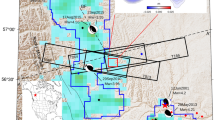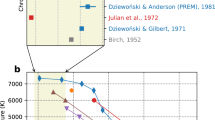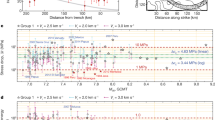Abstract
IN 1914, Gutenberg1 published an analysis of earthquake waves arriving at great distances, in which he inferred the existence of a major surface of discontinuity at a depth of about 1,800 miles, bounding a central core within the earth. His predictions regarding the characteristics of eompressional (P) waves transmitted through this core have been abundantly verified. But until recently, no signs have been forthcoming of the existence of distortional (S) waves that had penetrated this central mass. The conclusion has thus gradually come to be accepted that the core is in a fluid or semi-fluid state, and is thus incapable of transmitting shear waves that reach its boundary. Two branches to both types of core waves were indicated by Guten berg's theory, and have been designated by Macelwane Pl and P2, S1 and S2 respectively.
This is a preview of subscription content, access via your institution
Access options
Subscribe to this journal
Receive 51 print issues and online access
$199.00 per year
only $3.90 per issue
Buy this article
- Purchase on Springer Link
- Instant access to full article PDF
Prices may be subject to local taxes which are calculated during checkout
Similar content being viewed by others
References
Über Erdbebenwellen VIIA. Nachr. Ges. Wess. Gott., 125 ; 1914.
Gerlands Bei. Geophys., 28, 165 ; 1930.
Proc. Imp. Acad. Tokyo, 8, 354 ; 1932.
Author information
Authors and Affiliations
Rights and permissions
About this article
Cite this article
BASTINGS, L. Shear Waves through the Earth's Core. Nature 134, 216–217 (1934). https://doi.org/10.1038/134216c0
Issue Date:
DOI: https://doi.org/10.1038/134216c0
This article is cited by
-
State of the Earth's Central Core
Nature (1934)
Comments
By submitting a comment you agree to abide by our Terms and Community Guidelines. If you find something abusive or that does not comply with our terms or guidelines please flag it as inappropriate.



